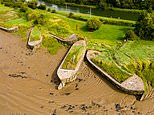
Decay and ruin have had a bad press.
They can be fascinating, as visitors to the Purton Ships’ Graveyard by the River Severn in Gloucestershire have attested to, with one describing the site – home to the weathered skeletons of abandoned ships from the previous century – as possessing an ‘eerie beauty’.
Pictures here show some of the 86 steel barges, concrete ships, and wooden cargo boats that were deliberately beached on the bank of the river to help prevent erosion and protect the adjacent canal – and that now form ‘the largest assembly of maritime artefacts on the foreshore of mainland Britain’, according to Friends of Purton.
This maritime cemetery – also known as Purton Hulks Graveyard – can be explored by walking along a two-mile section of the Severn Way that runs between the Gloucester and Sharpness Canal and the river from the village of Purton.
Visit Stroud says the vessels were mostly ‘deliberately beached’ in the 1950s.
The Purton Ships’ Graveyard by the River Severn in Gloucestershire has been described as possessing an ‘eerie beauty’
Eighty-six steel barges, concrete ships, and wooden cargo boats were deliberately beached on the bank of the River Severn to help prevent erosion
This maritime cemetery – also known as Purton Hulks Graveyard – can be explored by walking along a two-mile section of the Severn Way that runs between the Gloucester and Sharpness Canal and the river from the village of Purton
Tripadvisor user ‘Ashley W’ writes: ‘Visitors to Purton Ships’ Graveyard will be struck by the eerie beauty of the decaying vessels, many of which have been slowly reclaimed by nature’
‘In total there are 86 vessels, though not all are easily recognisable,’ it adds.
Among them is a barge called Harriett, listed by Historic England as a ‘scheduled monument’.
Built in 1905 and beached in 1964, the timber and iron vessel, ‘representative of a once more common local vessel type’, provides ‘insight into late 19th-century boat-building construction techniques’.
Also at Purton Hulks are six examples of Stroudwater barges that were ‘developed especially for the Stroudwater Navigation canal, which runs through Stonehouse, Stroud and towards Brimscombe’, according Visit Stroud.
‘There are believed to be none that survive today, apart from wrecks,’ it says.
The site, which is free to visit, is praised on Tripadvisor by several users.
Visit Stroud says the vessels were mostly ‘deliberately beached’ in the 1950s
The site is historically significant for multiple reasons – one being that the ruins shed light on late 19th-century boat building construction techniques
Accessibility to the site is along well-trodden paths, with Tripadvisor user ‘GloucesterWiz’ describing the walk to it as ‘really lovely’
One visitor to the site revealed that information notices are dotted around
Purton Ships’ Graveyard proves that decay and ruin isn’t necessarily a bad thing
‘Ashley W’ writes: ‘Visitors to Purton Ships’ Graveyard will be struck by the eerie beauty of the decaying vessels, many of which have been slowly reclaimed by nature.
‘As you wander through the site, you’ll see rusted hulls, skeletal frames, and remnants of machinery, all of which serve as a haunting reminder of the ships’ former lives and the people who worked on them.
‘Whether you’re interested in maritime history, industrial archaeology, or simply enjoy exploring off-the-beaten-path destinations, Purton Ships’ Graveyard is well worth a visit.’
In another review, titled ‘stunning scenery’, user ‘GloucesterWiz’ says: ‘Really lovely, peaceful, scenic walk that has well-formed or trodden paths that generally make accessibility good.
‘Plenty to see and bits of information dotted around.’
Describing their experience at the site, user ‘John S’ says: ‘The car park and the adjoining road was packed with cars, so we realised this is a popular destination.
‘As you wander through the site, you’ll see rusted hulls, skeletal frames, and remnants of machinery, all of which serve as a haunting reminder of the ships’ former lives and the people who worked on them,’ says ‘Ashley W’ on Tripadvisor
The adjacent Gloucester and Sharpness Canal was ‘the broadest and deepest in the world’ when it opened in 1827. It was designed to import raw materials to the Midlands ‘more easily’ and export finished goods, reducing costs
‘Lots of people walking, most wearing wellies and lots of dogs and children.
‘The path was quite muddy in places but not impassable and it was a lovely walk with the canal towpath on one side and the Severn on the other side.
‘Two-thirds of the way along towards Sharpness, you see the ruins of the old railway bridge.’
The Gloucester and Sharpness Canal was ‘the broadest and deepest in the world’ when it opened in 1827, measuring 86ft 6in wide (26m) and 18ft (5.4m) deep, according to the Canal and River Trust.
It was designed to import raw materials to the Midlands ‘more easily’ and export finished goods, reducing costs, it says.
Eighty-two years later, in 1909, the bank collapsed near Purton and the plan to deliberately beach old ships began, continuing for more than 60 years, the trust adds.
FIVE OTHER FASCINATING SHIP GRAVEYARDS WORLDWIDE
Bay of Nouadhibou, Mauritania
Incredible hulks: There are around 300 abandoned ships in Nouadhibou, Mauritania
This ship graveyard in the port city of Nouadhibou in Mauritania, north-west Africa, harbours around 300 ships.
The owners have taken advantage of a corrupt local government, which saved them dismantling costs by accepting bribes for allowing the ships to be left in the harbour, according to Atlas Obscura.
It was once a ‘thriving’ hub christened as ‘Port Etienne’ by French colonists in the early 1900s, according to marine insight.
When the country gained independence in 1960, its economy ‘was left shattered’ and the port became became a ship graveyard before the end of the century, it adds.
Great Lakes, North America
The wreck, which lies in the Fathom Five National Marine Park in Ontario, is popular with divers and snorkellers
North America’s Great Lakes are a recreational mecca, offering all manner of watersports and scenic cruises.
They’re also a gigantic graveyard – of around 6,000 shipwrecks that lie in lakes Superior, Huron, Michigan, Erie and Ontario, which collectively cover an area larger than the UK and Ireland put together.
Over 30,000 mariners lives have been lost on these colossal bodies of water.
Solomon Islands
The huge wreck of the MS World Discoverer in the Solomon Island archipelago
This incredible picture shows the huge wreck of the MS World Discoverer lying mere yards from a tourist beach in the Solomon Island archipelago in the Pacific Ocean.
Measuring 287ft (87m) in length, the enormous abandoned vessel looks startlingly incongruous next to the rugged natural beauty of the forested shoreline.
It’s not the only shipwreck in the Solomon Islands archipelago – in fact, it’s estimated there are around 200 wrecks scattered off its shores, making it a mecca for divers and history buffs alike.
Many of the wrecks were the result of fierce combat between Allied and Japanese forces during World War II. Other notable sunken ships include the Japanese vessels Hirokawa Maru and Kinugawa Maru, which both lie in waters to the west of Honiara. There are also hundreds of sunken WWII aircraft – including a Japanese Mitsubishi A6M Zero long ranger fighter aircraft, an America Grumman F6F 3-Hellcat and a Boeing B-17 Flying Fortress.
Skeleton Coast, Namibia
A colossal shipwreck on Namibia’s Skeleton Coast – which has a notorious reputation as a ‘graveyard for unwary ships’
This stretch of coastline ‘has long been a graveyard for unwary ships and their crews, hence its forbidding name’.
So says Lonely Planet, which adds: ‘Early Portuguese sailors called it As Areias do Inferno (The Sands of Hell), as once a ship washed ashore, the fate of the crew was sealed.’
Moynaq Ship Graveyard, Uzbekistan
Moynaq Ship Graveyard is dotted with the carcasses of trawlers that once roamed the Aral Sea
Moynaq was once a bustling fishing port on the shores of the Aral Sea, once the world’s fourth biggest lake.
Now it’s home to a ship graveyard dotted with the carcasses of trawlers.
The Aral was nearly destroyed as a result of the Soviet Union’s plan to boost cotton production by diverting Syr Darya and Amu Darya, the two rivers feeding it, to irrigate the desert.
By the 1990s, when the Soviet Union fell apart, the Aral had split into several smaller bodies of water.
Source link
CHECK OUT: Top Travel Destinations
READ MORE: Travel News



